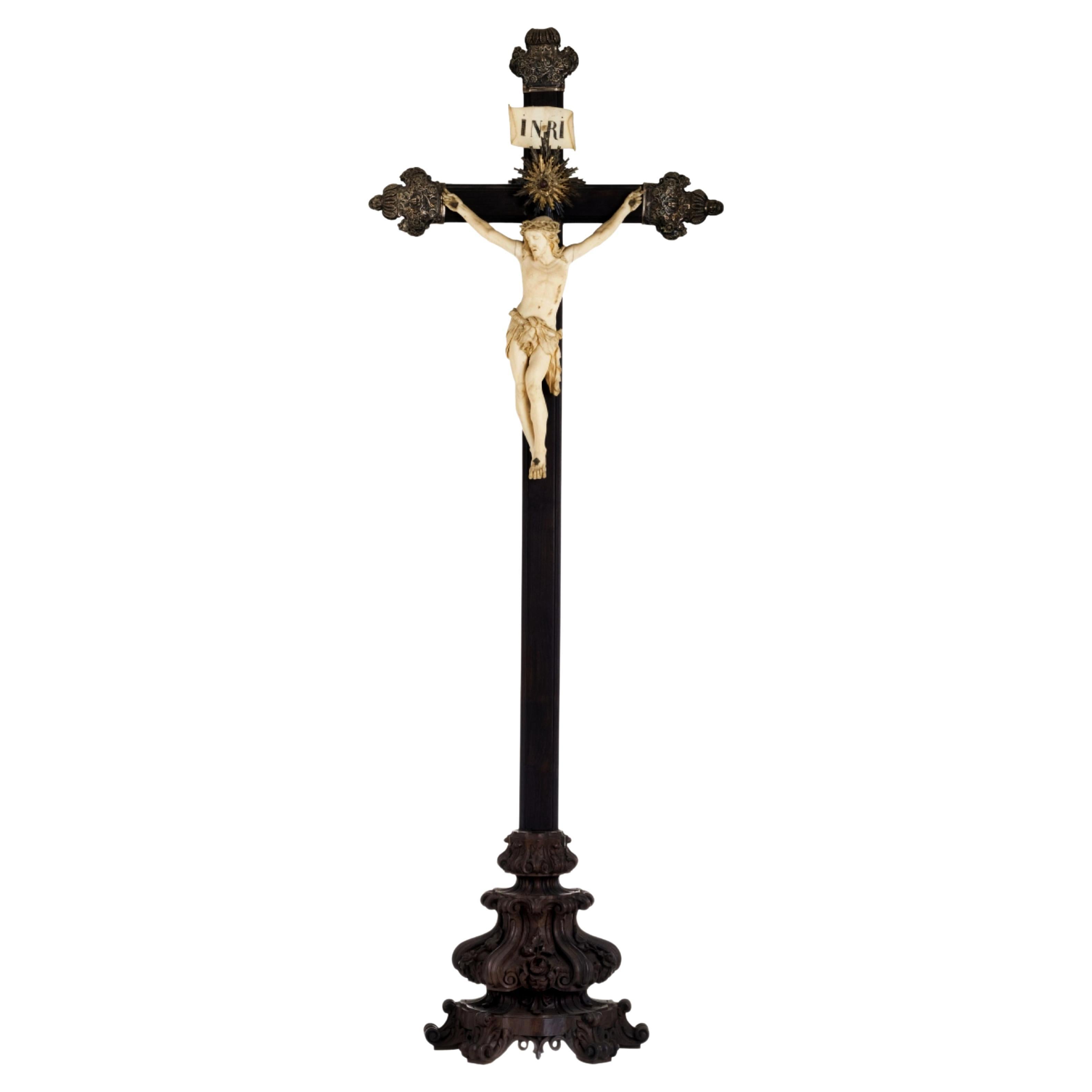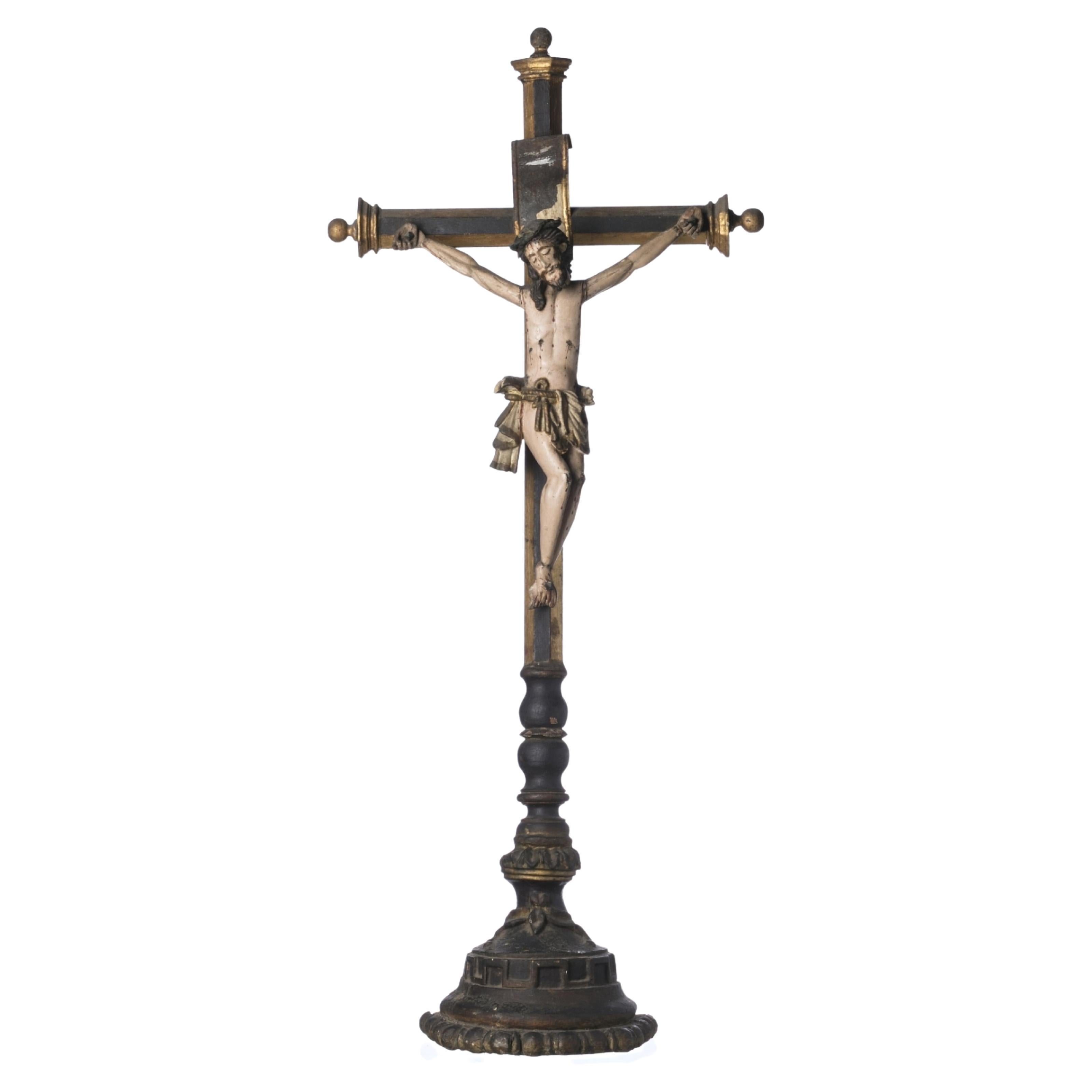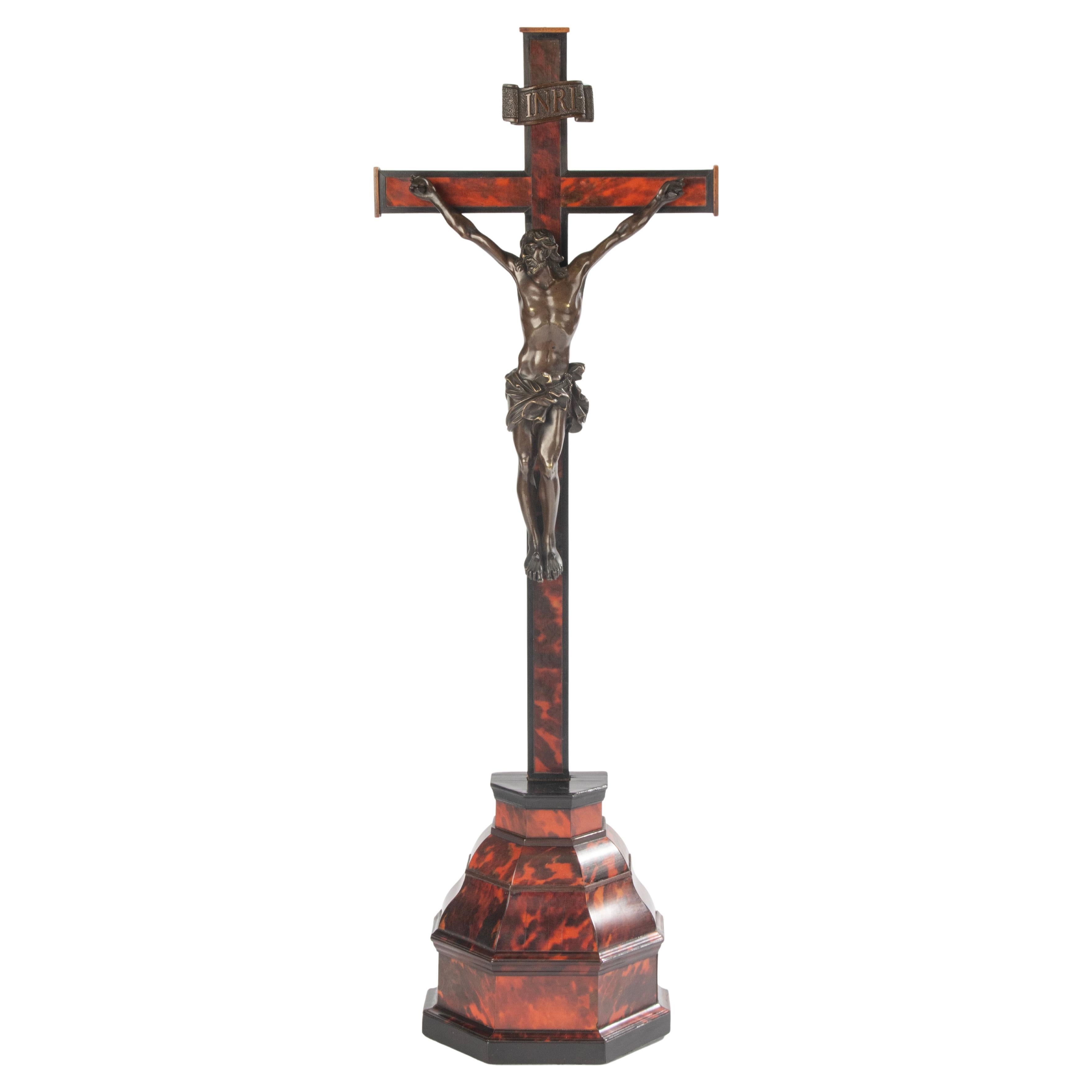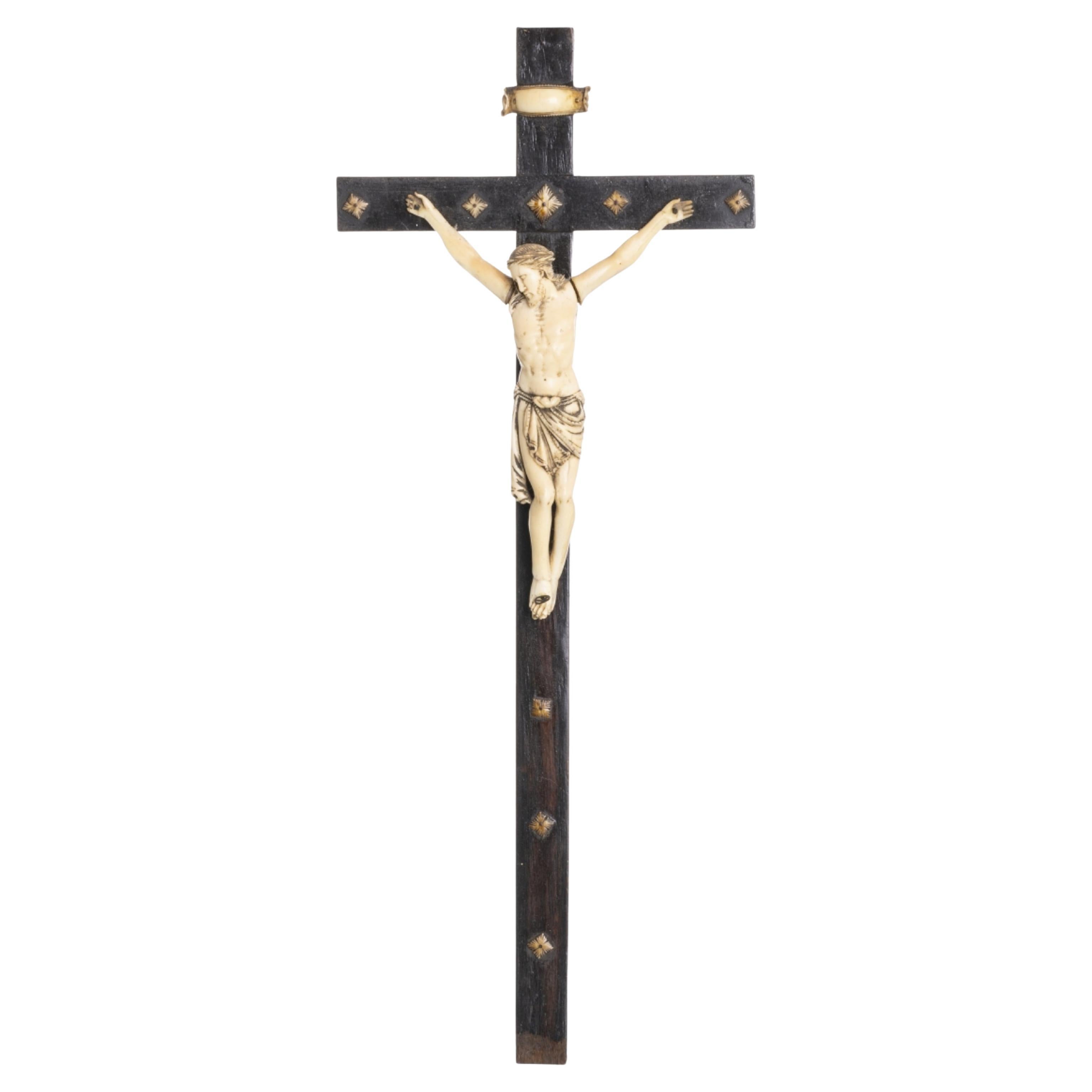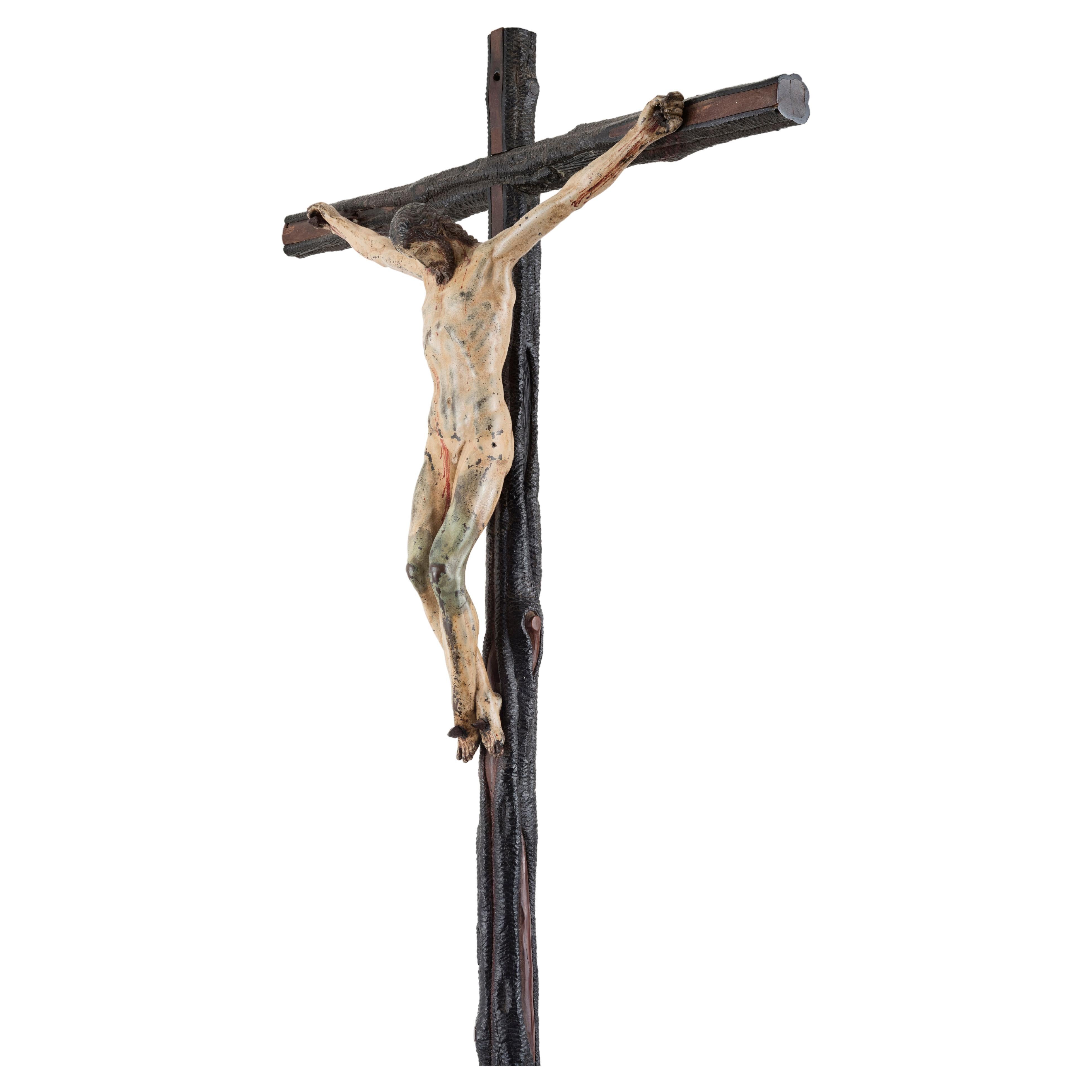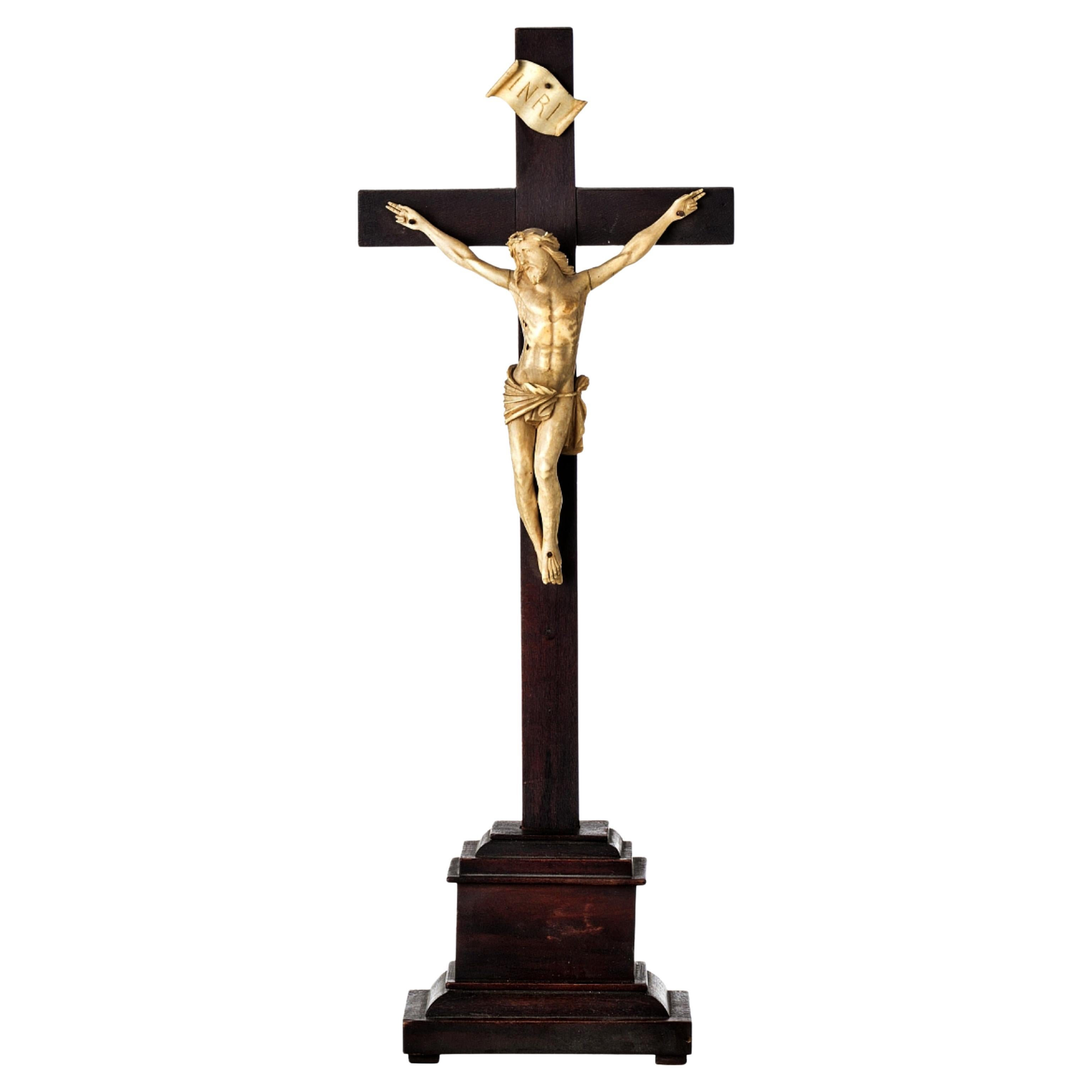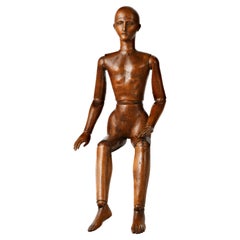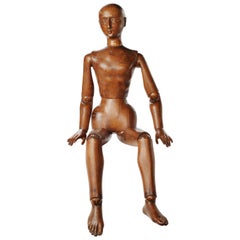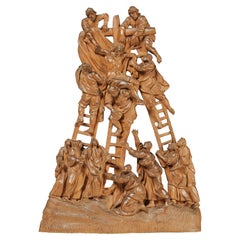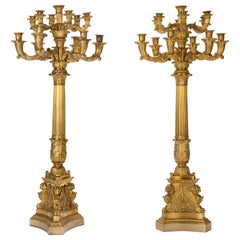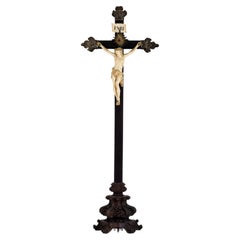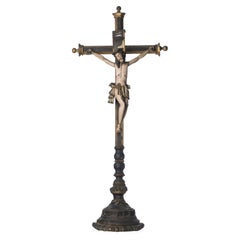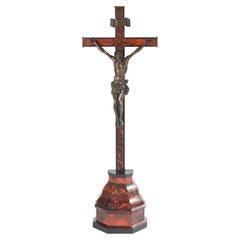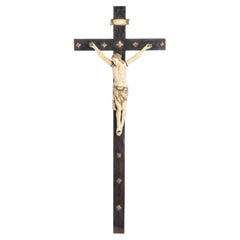Articoli simili a Crucifix, Bronze, iron, and wood, Lombardy, mid-17th century
Caricamento del video
Vuoi altre immagini o video?
Richiedi altre immagini o video al venditore
1 di 17
Crucifix, Bronze, iron, and wood, Lombardy, mid-17th century
14.500 €IVA inclusa
Informazioni sull’articolo
Crucifix
Lombardy, mid-17th century
Bronze, iron, and wood
Sculpture: 33 cm height x 35 cm width x 10 cm depth at the knees;
Cross: 42.12 in height x 19.68 in width (107 cm x 50);
Base: 13.38 in height x 13.58 in width x 7.08 in depth. (34 cm x 34.5 x 18)
Total dimensions: 54.33 in height x 19.68 in width x 7.08 in depth (138 cm x 50 x 18)
Weight: 18.07 lb (8.2 kg)
State of conservation: some signs of wear on the bronze patina, a dent on the halo.
The sculpture depicts Christ dead on the cross, with his head tilted to the right and his arms stretched upwards and to the side. The body is positioned frontally with the right leg slightly twisted at the knees. The loincloth is very minimal and gathered on the right with a knotted cord. The head is surmounted by an iron halo fixed by a nail. The wound from the spear that pierced Christ after his death, as well as the drops of blood and water that flowed from it, are reproduced on his side. The face is delicately modelled with defined features, closed eyes and mouth, and beard and moustache. The hair, parted in the middle, falls in long strands forward and down the back to the right.
The crucifix model can be traced back to some works designed by Guglielmo Della Porta (ca. 1515-1577), a sculptor, architect, and restorer of Italian Mannerism, who was trained in Genoa and Rome. He was a disciple of Michelangelo and later a sculptor at the Farnese court.
Over time, this model was attributed to Giambologna (1529-1608), who was active in the creation of crucifixes around the 1570s. This is an idea that still has various supporters (Michael Riddick, Reconstituting a Crucifix by Guglielmo Della Porta and his Colleagues. The "Great School" of Guglielmo Della Porta, Part 2, 2017 link).
More recent studies, instead, follow a different path to reconstruct the history of this sculpture and tell us with certainty that in 1569 Alessandro Farnese (1520-89) requested that Guglielmo Della Porta produce "some crucifixes in solid silver and other gilded metals" for St. Peter's Basilica (Anna Beatriz Chadour, The Altar Set by Antonio Gentili in St. Peter's, Rome. Wallraf-Richartz-Jahrbuch, vol. 43, 1982, pp. 133-193). Guglielmo's workshop was one of the most active at the time, as confirmed by the large number of crucifixes inventoried at the time of his death in 1577: the list includes at least 58 examples, in various stages of production, ranging from 22 to about 70 centimeters in size (Rosario Coppel, Catalogue (Christ Crucified). Guglielmo Della Porta, A Counter-Reformation Sculptor, Madrid 2012, pp. 62-73).
In well-organized workshops, it was customary for much of the production of replicas to be entrusted to the master's collaborators and pupils. It is very likely that this was also the case in Guglielmo's workshop, where it is possible to find various examples starting from one of his prototypes and resulting in inevitable, and at times great, variations
Among the works of artists who collaborated with the master, the model closest to ours seems to be that of Antonio Gentili da Faenza, the presumed author of the example kept in the Apostolic Palace of the Sanctuary of Loreto.
The corpus of works associated with the Loreto crucifix also includes the model conceived by Guglielmo in 1571 for Cardinal Alessandro Farnese and later elaborated by Gentili, as evidenced by some epistolary documents (State Archive of Naples cited in Rosario Coppel, Guglielmo Della Porta in Rome. Guglielmo Della Porta, A Counter-Reformation Sculptor. Madrid 2012, pp. 28-57).
In this regard, it has been noted how in the Farnese altar cross in the Vatican, Gentili's finishing can be seen in some evident variations from Della Porta's original design: for example, in the circular shape of Christ's umbilicus (triangular in Della Porta's model), in the treatment of the hair, the shape of the hands, and especially the loincloth, which is completely reworked and draped at the back of Christ's right leg.
Therefore, Guglielmo's prototype, perfected and cast by Gentili, proves that the Loreto crucifix is not an invention of Giambologna, but represents one of the many workshop variants based on Guglielmo's Crucifix of 1571 for Alessandro Farnese in the Vatican (Michael Riddick, op. cit., p. 15).
The model of Christ on the cross by Della Porta and its variants have had great success over time, becoming one of the most widely used templates to meet the demands of religious commissions and private devotion.
The work in question is accompanied by an important ebonized wooden base, which, in morphology and style, can be associated with Lombard production of the 17th century and the early decades of the 18th. The style of the base is evidently found in decorative formulas that are repeated in the architectural plinths of the cornices of palaces or in the brackets of Lombard churches up to the decorative components of contemporary furniture and objects. This style, in our opinion, is consistent with the crucifix and in harmony with the dictates of the Council of Trent, now fully embraced, which supported a new form of art suitable for promoting the message of the Christian Catholic Church, even through beauty and a certain, often theatrical, decorativeness.
Bibliography:
Michael Riddick, Reconstituting a Crucifix by Guglielmo Della Porta and his Colleagues. The “Great School” of Guglielmo Della Porta, Part 2, reconstituting-a-crucifix-by-guglielmo-della-porta-and-his-colleagues/, and related bibliography;
Rosario Coppel, Guglielmo Della Porta in Rome. Guglielmo Della Porta, A Counter- Reformation Sculptor. Coll & Cortés 2012;
Werner Gramberg, Sechs Sammler Stellen Aus. Museum für Kunst und Gewerbe Hamburg, Amburgo, 1961, No. 43;
Werner Gramberg, Das Kalvarienbergrelief des Guglielmo Della Porta und seine Silber-gold-Ausführung von Antonio Gentili da Faenza. Intution und Kunstwissenschaft. Festschrift für Hans Swarzenski. Berlin 1973;
Werner Gramberg, Notizen zu den Kruzifixen des Guglielmo Della Porta und zur Entstehungsgeschichte des Hochaltarkreuzes in S. Pietro in Vaticano
In Münchner Jahrbuch der bildenden Kunst vol. 32, 1981;
Ulrich Middeldorf, Palazzo Vecchio: committenza e collezionismo medicei, Firenze e la Toscana dei Medici nell ‘Europa del Cinque cento. Firenze 1980. N. 674;
Anna Beatriz Chadour (1982): Der Altarsatz des Antonio Gentili in St. Peter zu Rom. Wallraf-Richartz-Jahrbuch, vol. 43.
- Dimensioni:Altezza: 138 cm (54,34 in)Larghezza: 50 cm (19,69 in)Profondità: 18 cm (7,09 in)
- Stile:Barocco (Del periodo)
- Materiali e tecniche:
- Luogo di origine:
- Periodo:Metà XVII secolo
- Data di produzione:Circa 1650
- Condizioni:Usura compatibile con l’età e l’utilizzo. Some signs of wear on the bronze patina, a dent on the halo.
- Località del venditore:Milano, IT
- Numero di riferimento:1stDibs: LU4352240552672
Informazioni sul venditore
4,3
Venditore professionale selezionato
Ogni venditore supera rigorosi standard di autenticità e affidabilità
Fondazione nel 1860
Venditore 1stDibs dal 2018
21 vendite su 1stDibs
Associazioni
International Confederation of Art and Antique Dealers' Associations
- SpedizioneRecupero del preventivo…Spedizione da: Milano, Italia
- Politica di reso
Alcune parti di questa pagina sono state tradotte automaticamente. 1stDibs non può garantire che le traduzioni siano corrette. L’inglese è la lingua predefinita del sito.
Garanzia di autenticità
Nell’improbabile caso in cui si verifichi un problema con l’autenticità di un articolo, contattaci entro un anno per ottenere un rimborso completo. DettagliGaranzia di rimborso
Se il tuo articolo non corrisponde alla descrizione, è danneggiato durante il trasporto o non arriva, contattaci entro 7 giorni per un rimborso completo. DettagliAnnullamento entro 24 ore
Hai un periodo di tolleranza di 24 ore per annullare il tuo acquisto, senza necessità di fornire spiegazioni.Venditori professionali selezionati
I nostri venditori di livello internazionale devono aderire a rigorosi standard di servizio e qualità, garantendo l’integrità delle inserzioni.Garanzia miglior prezzo
Se scopri che un venditore ha pubblicato altrove lo stesso articolo a un prezzo più basso, applicheremo lo stesso prezzo.Consegna globale affidabile
La nostra rete di vettori leader del settore offre opzioni di spedizione specializzate in tutto il mondo, inclusa la consegna personalizzata.Altro da questo venditore
Mostra tuttoManichino in legno italiano del XIX secolo, 1870-1880 circa
Manichino
Legno scolpito e intagliato
Italia o Francia, seconda metà del XIX secolo.
Misura 25,59 x 6,29 x 3,54 pollici (65,5 x 16 x 9 cm).
Pesa 2,2 lb circa (1 kg circa)
Stato ...
Categoria
Di antiquariato/d’epoca, Anni 1870, Italiano, Altro, Sculture figurative
Materiali
Legno
Manichino in legno italiano della fine del XIX secolo, circa 1880
Manichino dell'Atelier A
pietra scolpita e intagliata legno di pino
Italia, fine del XIX secolo
Misure: H. 102 cm x 25 cm x 14 cm
H. 40,15 poll. x 9,84 poll. x 5,51 poll.
Peso: ...
Categoria
Di antiquariato/d’epoca, Anni 1880, Italiano, Altro, Sculture figurative
Materiali
Legno
Antica deposizione di microintaglio in legno di bosso, prima metà del XVIII secolo
Micro intaglio del bosso
Deposizione
Europa centrale, prima metà del XVIII secolo
Misura: la scultura 7,40 x 5,31 x 0,6 pollici (18,8 x 13,5 x 1,6 cm); con la tavoletta 9,37 x 8,7 x ...
Categoria
Di antiquariato/d’epoca, Anni 1740, Europeo, Barocco, Sculture figurative
Materiali
Bosso
Coppia di candelabri in bronzo dorato francese o russo del XIX secolo, circa 1830
Coppia di candelabri a tredici fiamme
Francia o Russia
Secondo trimestre del XIX secolo
Bronzo fuso, cesellato e dorato
Altezza 40.95 in (cm 104), diametro 17,7 in (cm 45)
97 lb (44...
Categoria
Di antiquariato/d’epoca, Anni 1830, Francese, Neoclassico, Candelabri
Materiali
Similoro
Madonna in argento del XIX secolo, circa 1830
Placca d'argento goffrata e incisa
La Madonna del lago
Probabilmente Milano, dopo il 1824
Telaio in ottone
Misura 16,14 pollici x 13,85 pollici (41 x 35,2 cm) e pesa 10,357 libbr...
Categoria
Di antiquariato/d’epoca, Anni 1820, Italiano, Neoclassico, Argento 925
Materiali
Argento 925, Ottone
Coppia di candelabri francesi a tre fiamme, circa 1860
Coppia di candelabri a tre fiamme
Bronzo fuso, cesellato e dorato al mercurio
Francia, terzo quarto del XIX secolo
Altezza 14,96 pollici (38 cm) X 12,59 (32 cm)
Peso di 5,2 kg (...
Categoria
Di antiquariato/d’epoca, Anni 1860, Francese, Napoleone III, Candelabri
Materiali
Bronzo
10.000 € / set
Ti potrebbe interessare anche
GESU' CRUCIFICATO XVIII secolo Scultura italiana
GESU' CRUCIFICATO XVIII secolo
Scultura italiana
in ivor.... La figura è rappresentata morta, con un punto cendale in vita. Croce in legno di palissandro intagliato. Terminali in ...
Categoria
Di antiquariato/d’epoca, Inizio XVIII secolo, Italiano, Barocco, Articol...
Materiali
Legno
GESÙ CRUCIFICATO Scultura portoghese del XVII secolo
GESÙ CRISTO CROCIFISSO
Scultura portoghese del XVII secolo
in legno intagliato, policromo e dorato.
Piccoli difetti nella policromia.
Altezza: (Cristo) 32 cm. Altezza: (totale) 86 c...
Categoria
Di antiquariato/d’epoca, XVII secolo, Portoghese, Barocco, Articoli reli...
Materiali
Legno
Crocifisso francese della fine del XIX secolo - Wood - Corpus Christie's in bronzo
Un raffinato crocifisso francese della fine del XIX secolo.
La croce è realizzata in legno lucidato e impiallacciato in finta tartaruga, creando un effetto caldo ed elegante. Montato...
Categoria
Di antiquariato/d’epoca, Anni 1870, Francese, Napoleone III, Articoli re...
Materiali
Bronzo
1200 €
Spedizione gratuita
GESÙ CRISTO CROCIFISSO Croce in Wood esotico, scultura portoghese del XIX secolo
GESÙ CRISTO CROCIFISSO
Croce in legno esotico, scultura portoghese del XIX secolo
scolpito in avorio...
Segni d'uso. Dim. Altezza: (cristo) 16 cm; (totale) 45 cm
buone condizioni
Categoria
Di antiquariato/d’epoca, XIX secolo, Italiano, Barocco, Articoli religiosi
Materiali
Legno
Raro e importante Crocifisso in bronzo dipinto su modello di Michelangelo
Di Michelangelo Buonarroti
Raro e pregiato corpo di Cristo in bronzo su modello di Michelangelo, fuso nel 1597-1600 circa da Juan Bautista Franconio e dipinto nel 1600 da Francisco Pacheco a Siviglia. 1597-160...
Categoria
Di antiquariato/d’epoca, XVI secolo, Rinascimento, Sculture figurative
Materiali
Bronzo
GESU' CRUCIFICATO XIX secolo Scultura italiana
GESÙ CRISTO CROCIFISSO
Scultura italiana del XIX secolo
in avorio... Cristo e tavola in avorio intagliato. Croce in palissandro brasiliano, intagliata. Piccoli difetti.
Altezza: (...
Categoria
Di antiquariato/d’epoca, XIX secolo, Italiano, Barocco, Articoli religiosi
Materiali
Legno
